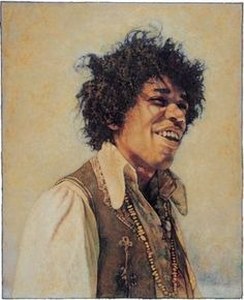Fact #118080
When:
Short story:
 The Jimi Hendrix Experience are recording Little Miss Lover at the start of a five day recording session at Olympic Sound Studios, London, UK.
The Jimi Hendrix Experience are recording Little Miss Lover at the start of a five day recording session at Olympic Sound Studios, London, UK.Full article:
Jimi Hendrix : … the secret of my sound is largely the electronic genius of our tame boffin (Roger Mayer) who is known as Roger The Valve. He has re-wired my guitars in a special way to produce an individual sound and he has made me a fantastic fuzz-tone … actually it's more a sustain than a fuzz. He got a special sound out of the guitar on One Rainy Wish and Little Miss Lover. It comes through a whole octave higher, so that when playing the high notes, it sometimes sounds like a whistle or a flute.
(Source : not known)
Andy Johns (producer/engineer) : I was very much aware of Jimi before I ever worked with him. I started working at Olympic in 1967, and he’d already had Hey Joe, Purple Haze, and The Wind Cries Mary come out, and those had transfixed me. I noticed that he was going to be doing another album at Olympic, so I begged and pleaded, and they put me on those sessions for Axis: Bold as Love. Of course, it was jaw-dropping stuff. Nobody played like that. His technique and expertise were very new, and we’d never heard anything like that.
As a rhythm player, Jimi was spectacular. He would play rhythm and melodic parts at the same time. It was like two guitar things happening at once. The interwoven rhythm things on Hey Joe are really amazing.
The guy could pretty much get any sound that he wanted. He was a magician. If he could hear it in his head, he could get it. Roger Mayer was always showing up with various octave boxes and things. Jimi used to sometimes use two Fuzz Faces and two wah-wahs in series, which I thought was somewhat self-defeating. He had all this power at his disposal with those three Marshall stacks, and he could get a huge range of sounds depending on where he would put the volume control on his Strat. In the studio, he would make Eddie Kramer get sounds that he would never have normally gotten. They got on very well. It was quite an experience, that Axis album. After that, I don’t know what happened. He got caught up in some other vibe or something. Electric Ladyland is good, but it didn’t seem to be an advancement to me.
(Source : Guitar Player, May 2012)
Tweet this Fact
(Source : not known)
Andy Johns (producer/engineer) : I was very much aware of Jimi before I ever worked with him. I started working at Olympic in 1967, and he’d already had Hey Joe, Purple Haze, and The Wind Cries Mary come out, and those had transfixed me. I noticed that he was going to be doing another album at Olympic, so I begged and pleaded, and they put me on those sessions for Axis: Bold as Love. Of course, it was jaw-dropping stuff. Nobody played like that. His technique and expertise were very new, and we’d never heard anything like that.
As a rhythm player, Jimi was spectacular. He would play rhythm and melodic parts at the same time. It was like two guitar things happening at once. The interwoven rhythm things on Hey Joe are really amazing.
The guy could pretty much get any sound that he wanted. He was a magician. If he could hear it in his head, he could get it. Roger Mayer was always showing up with various octave boxes and things. Jimi used to sometimes use two Fuzz Faces and two wah-wahs in series, which I thought was somewhat self-defeating. He had all this power at his disposal with those three Marshall stacks, and he could get a huge range of sounds depending on where he would put the volume control on his Strat. In the studio, he would make Eddie Kramer get sounds that he would never have normally gotten. They got on very well. It was quite an experience, that Axis album. After that, I don’t know what happened. He got caught up in some other vibe or something. Electric Ladyland is good, but it didn’t seem to be an advancement to me.
(Source : Guitar Player, May 2012)